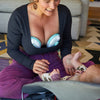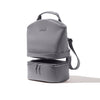Yep, mastitis is the worst. The last thing you need are painful and swollen boobs when you’re trying to feed your baby! The good news? You’re not alone. Mastitis occurs in 10% of women who breastfeed, and is easily treatable. Even better, you can still safely feed your baby with mastitis. Keep reading to learn everything you need to know about pumping with mastitis.
What is mastitis?
Mastitis is an inflammation of the breast tissue that is often a result of infection from bacteria entering the breast or a clogged milk duct. Symptoms include breast tenderness, swelling, fevers, red skin, and pain while breastfeeding. Mastitis typically appears in one breast, and the first symptoms arise in the form of red, warm skin and engorgement.
Mastitis does not lessen the quality of breast milk, so it is safe to feed your baby with mastitis. Mastitis should still be treated ASAP to prevent further infection, and the likelihood of (deleted “you”)getting it again.
Types of mastitis
There are two types of mastitis: lactation and periductal. Lactation mastitis is the most common, and affects women during breastfeeding. While it is less common, it is possible for all genders to get mastitis without nursing if there is a clogged duct that is left untreated.
Periductal mastitis is more common in those who are menopausal, postmenopausal are smokers, obese or diabetic. In other words, periductal mastitis affects non-lactating women, and causes milk ducts to thicken.
Plugged duct vs mastitis - What is the difference?
Plugged milk ducts have similar symptoms to mastitis, but there are some key differences that set them apart. Plugged ducts appear as small lumps on the breast with some pain and swelling around the area of the lump. These small lumps are often the result of not pumping or feeding enough, and milk begins to clog the ducts.
If a plugged duct is not treated quickly, it can turn into an infection leading to mastitis. Fevers and flu-like symptoms are only signs of mastitis and not plugged ducts. If you think you have a plugged duct, seek treatment immediately so that it doesn’t worsen over time.
How long does mastitis last?
Doctors typically prescribe a 10 day dose of antibiotics for a case of mastitis. If you visit a doctor promptly after having mastitis symptoms and take the full antibiotic dosage, you will be feeling better by the end of the 10-day dose.
Because mastitis is an infection, it will not go away easily on its own unless properly treated. If you begin to feel some of the preliminary symptoms like breast tenderness and engorgement, it’s important to keep feeding and pumping to stimulate your milk flow. If the symptoms worsen after 8-12 hours, visit a doctor for consultation.
What causes mastitis?
Mastitis is commonly caused by bacteria entering the breast which causes an infection, or an untreated plugged milk duct - there are a variety of risk factors if this occurs. Having dry, cracked nipples can be a route for infection.
Poor breastfeeding technique is also a possible risk factor for lactation mastitis. Weaning or missed feedings fall under the category of potential negative effects on milk duct health. Stress and sleep deprivation are also known risk factors, and many moms associate their mastitis with breast trauma, fatigue, and stress.
Can I breastfeed if I have mastitis?
You can breastfeed if you have mastitis! In fact, you should. Frequently breastfeeding may help with clearing out the infection more efficiently. Because mastitis is often caused by bacteria or milk clogged in your milk ducts, continuing to breastfeed will help to stimulate your milk flow and flush your system. To recap...your breastmilk is still safe for your baby if you have mastitis.
Should I pump with mastitis?
Even if you are exclusively pumping, you should continue to pump with mastitis! Ultimately you need to get the milk out of your breasts to relieve some of the engorgement and pain, and pumping can help with that. Adding a few more pumping minutes onto the affected side can help to ensure your pumping effectively every time.
LaVie Warming Lactation Massager
LaVie Warming Lactation Massager
With LaVie, you'll say hello to improved milk flow, quicker pumping sessions, more effective emptying during pumping and nursing, and clogged duct prevention.
Things to do to lessen the pain of pumping with mastitis
Mastitis can be terribly painful, especially when you have to feed your baby! Don’t give up, we created a list of steps you can take to lessen the pain of pumping with mastitis:
Before pumping
- Use heat with a warm compress to gently create supple skin
- Loosen clothing and bra
- Massage the breast area to release tension
During pumping
- Pump on the affected breast first.
- Use whatever positioning is most comfortable and helps the area to be massaged
- Massage while pumping
After feeding
- Pump or express to aid drainage and speed healing
- Use cold compresses between feedings for pain and to reduce swelling
General advice
What increases your risk of getting mastitis?
Your risk of getting mastitis increases if you:
-
Leave a clogged duct untreated: If not treated immediately, clogged ducts can become infected and turn into mastitis.
-
Had a previous case of mastitis: It is possible to get mastitis more than once. Recurring mastitis may be the result of a nursing issue, contact a lactation consultant for advice.
-
Miss breastfeeding or pumping sessions: If you’ve missed a feeding or pumping session, this may give more time for bacteria to cause infection within your milk ducts. Feeding and pumping frequently helps to open the ducts and push out any impurities.
-
Cracked or sore nipples: Cracked nipples have small lesions that are more susceptible to bacteria. Apply vaseline and lotion to the affected area, and use a pump if breastfeeding becomes too painful.
-
Smoke tobacco: Cigarette smoking directly affects your vulnerability for mastitis. If you’ve been trying to quit, now is your best reason!
-
Poor nursing positions: Nursing in just one position, or not using an effective position can affect your milk supply and cause your ducts to close.
Do Pumps Cause Mastitis
If you are exclusively pumping, the likelihood of your pump causing mastitis is low. Problems with pumping only arise if moms alternate variably between breastfeeding and pumping. Often a baby will not eat as much as a mom pumps, which can lead to breast engorgement and plugged ducts.
Don’t stop pumping with mastitis! By pumping frequently you are helping your body get back on track. Still have questions? We’ve got you covered. Check out our articles on exclusive pumping schedules, breastfeeding with mastitis, low milk supply, and more. At Willow, we want all moms to have a positive nursing experience. Join the Willow community today and let’s kick mastitis where it starts!
Get pumping support with Simplifed
Get pumping support with Simplifed
Get access to free virtual feeding support from the lactation consultants at Simplifed. They can help you navigate supply issues, introduce a bottle, and more, and are trained on Willow pumps.























